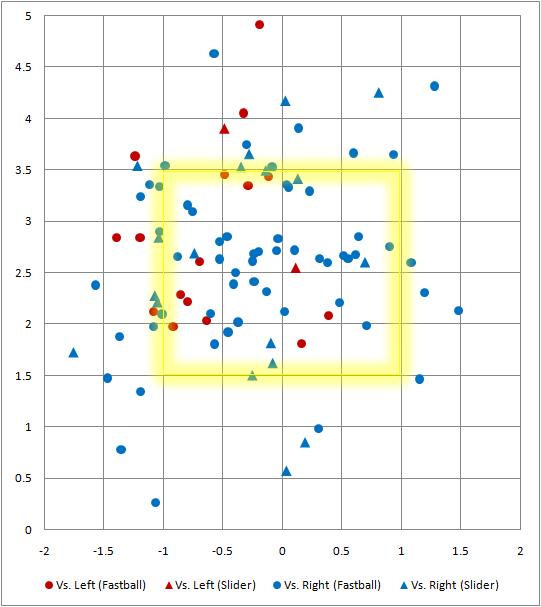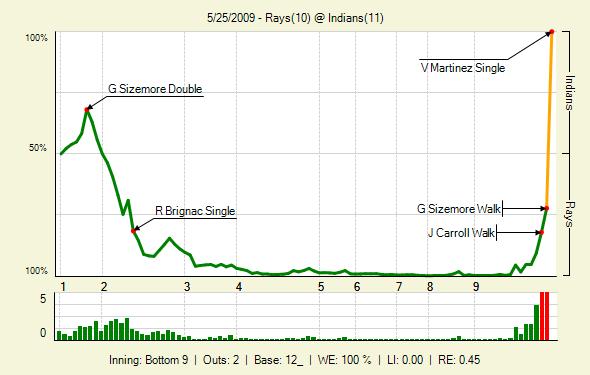
| Touching Bases | May 26, 2009 |
For Cleveland sports fans, I don’t know if any moment could top LeBron James’ game-winning three pointer from Friday night. Last night’s ninth-inning comeback by the Indians wasn't half bad.
For Tampa Bay fans, though, last night's game was of greater importance than its bullpen collapse. Last night, David Price made his first start of the year.
Pitching in five regular season and five postseason games last year, Price served as an instrumental part in the Rays’ playoff run. Nevertheless, Price retained his rookie eligibility, and the Rays, managing a surplus in pitching, opted to option the 23-year old southpaw down to AAA and keep youngsters Andy Sonnanstine and Jeff Niemann in the rotation as well as limit Price’s innings.
Following Price's phenomenal postseason performance, Josh Kalk penned everything you need to know about the man, who was named the second-best prospect in baseball (behind Matt Wieters) by Keith Law, Kevin Goldstein, and Baseball America.
In spring training, Price went 2-0 with a 1.08 ERA, but his six walks allowed in 8.1 innings of work were a bad sign. After Price’s second spring appearance, he admitted that he was experiencing difficulty.
"I've worked on my changeup so much, my slider's gone away," Price told mlb.com. "It's something I'm going to have to get back."
Considering the hype Price received, it's hard to believe that he still had areas where he needed to improve, but he's still just a kid with only a year of professional ball under his belt.
Price’s first six starts with AAA Durham were worrisome, as he posted a 1-4 record due to a disappointing 21:16 K:BB ratio. Price was drawing fewer swinging strikes and he was not inducing nearly as many ground balls in his 2009 stint with Durham as he had in 2008 across four levels. Yet Price seemed to have turned it around in the last couple of weeks leading up to his start yesterday. In what might be his final Minor League appearance of his career (knock on wood) Price went five innings of no-hit ball while striking out nine. Price entered the Rays' rotation when Scott Kazmir, to whom Kalk compared Price, hit the Disabled List. I set out to break down the second start of Price's Major League career.
Price came out firing. His first 14 pitches were four-seem fastballs clocking in between 94 to 98 miles per hour. Jamey Carroll drew for a leadoff walk, followed by Grady Sizemore hitting a pop up down the left field line, Carl Crawford made a futile attempt at a diving catch, which allowed runners to advance to second and third with no outs. Then Price really flashed his potential.
Price worked ahead of the count on Victor Martinez with fastballs, and with two strikes, Martinez had little chance. Price busted Martinez inside with sliders which Martinez could do little else but foul off. Price then blew Martinez away with a 98-MPH fastball on the outside part of the plate. Price worked ahead of Jhonny Peralta with inside fastballs and finished him off with a hard slider inside. Price finished the inning by testing Shin-Soo Choo with fastballs up in the zone, and on 2-2 Price threw a heater over the heart of the plate that Choo took for a called strike three.
Needless to say, that stretch was Price’s most impressive, which is fair since it doesn’t really get much better than that.
The Rays gave Price a fiive-run cushion heading into the bottom of the second. However, Price walked the leadoff batter on four pitches, which just makes you wonder. There’s no reason that any Major League pitcher with a five run lead should be walking the leadoff batter on four pitches. Price allowed five walks, which is the second time in his last four starts that he’s allowed that many. Walks have been a problem for Price. Since being promoted to AAA last year, Price has walked well over four batters per nine innings.
Let's take a look at Price's strikezone plot. This is from the catcher’s perspective, so pitches on the right are towards Price’s arm side, or inside to left-handed batters. Blue markers are pitches against righties, while red markers are pitches against lefties. Circles indicate fastballs while triangles indicate sliders.

It looks to me like he tried to work away from lefties. His off-speed stuff was saved almost exclusively for righties, and he tried to keep his sliders in on them. Looking at his strikezone plot, I don't think Price was wild, but he didn't shy away from working himself into long at bats, which is unnecessary given that defense behind him and his ability to blow batters away.
Despite the leadoff walk in the second, Price retired the next three batters in order. With a full count on Ryan Garko, Price demonstrated the ability to keep the ball in the zone when necessary, as he forced Garko to foul off five pitches in the zone before popping out on a slider on the outside corner.
Price allowed two more baserunners in the third, but came out unscathed. The fourth inning was where it all started falling apart for Price and the Rays. The Rays had a 10-0 lead, yet Price was already at 77 pitches by the start of the inning, and his fastballs to the first two batters of the inning were down in velocity to 92-94 MPH. Mark DeRosa lined a single the other way and Garko pounded his third homer of the year on a knee-high fastball. Price picked the velocity back up against Matt LaPorta, working at 95-97 with his fastball to strike LaPorta out. Yet Price was up at 90 pitches, and he had apparently lost his command. Price walked the next two batters and was pulled by Joe Maddon, who had said in a pre-game interview that it was a goal for Price to go deep into the game. Neither of those baserunners came around to score, but Price was fortunate to forfeit only two runs after allowing nine baserunners in 3.1 innings.
Price, as usual, was 95% fastball/slider. He showed his spike curveball and changeup once or twice, but they were all wasted for balls.
I’d say he found his slider. Like last year, it averaged a velocity of 86-88 miles per hour. While Price doesn't generate significant horizontal movement, he actually got the ball to dive more in yesterday's start than he did on average last year. He releases his slider a couple inches farther from his body than he releases his fastball on average. There aren't many sliders thrown at 86-88, especially from the left side. Last year, Francisco Liriano and Randy Johnson threw the hardest sliders among left-handers. Both of them had little horizontal movement, like Price, and Liriano's and Johnson's sliders actually generated less vertical movement than Price's has. Nevertheless, all of these sliders have solid reputations and they have all accounted for above-average run values, which can now be found on Fangraphs. Swinging at Price's slider simply isn’t a good idea. Out of eight swings on his sliders, there were five fouls, two misses, and one pop out. However, when batters took the slider, only two called strikes were called out of twelve pitches. If he can locate the slider down in the zone, I believe it would be nearly untouchable.
His fastball averaged 96 MPH, which, for a starter, for a lefty, and for a human whose arm must follow the laws of biomechanics, is positively exceptional. The movement on it is nothing to write home about, though, in my opinion.
Price’s stuff is unbelievable. There’s no denying that. But walking that many batters is inexcusable, and it cost his team the game. Price has yet to have an outing of over six innings since he was called up to the Majors last year. Part of that is due to the Rays’ attempt to limit his innings. And part of that is Price’s propensity to throw too many pitches. The Rays were forced to go to their bullpen early, and they ended up not having enough arms to close out the game. Well, that’s not really fair. A bullpen should be able to close out a ninth-inning seven-run lead. Here’s the WPA chart from the biggest comeback of the year.

Comments
Whoa, Jeremy... he left early, but he had an 8-run lead! Isringhausen and company cost them that game. I see your point that working 5 2/3 innings can be tough, but that's why teams carry twelve pitchers.
In the postgame, Isringhausen shared that he'd rather give up a home run than walk a guy, even though he could still have saved the game after three walks, by retiring Martinez. (Any of those hitters would have at least tied the game on a homer.) Sometimes I really miss FJM.
Posted by: nightfly at May 27, 2009 9:53 AM